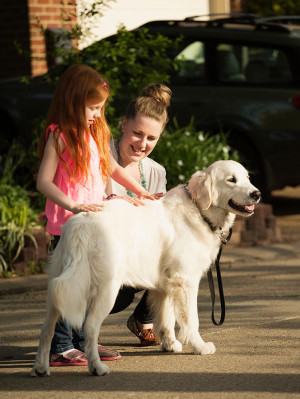Should You Let Your Dogs Share Bowls?
And other incredibly valid bowl-safety questions you’re probably asking.

Share Article
If you live in a household with more than one dog, you may have wondered whether you can feed your dogs simultaneously from the same bowl. (And if you haven’t wondered that, you may have just read that sentence and thought, “Wait — what?!” But believe me, it happens!)
Even if it might seem more convenient, the truth is that using the same food bowl for multiple dogs is a bad idea for a couple different reasons. We spoke to experts about why it should be avoided, whether water bowls are different, and what you should do instead.

Save on the litter with color-changing tech that helps you better care for your cat.
Why shouldn’t you feed multiple dogs from the same bowl?
“It is definitely not a good idea to have two or more dogs eating from the same bowl,” Diana Cron, president of the Ohio Veterinary Medical Association, tells us. Dr. Cron offered a few different reasons why. First, your dogs likely have different caloric needs in order to remain healthy, and may need different portions of food. Beyond that, they may have certain medical conditions that require different types of food. “Dog diets are not one-type-fits-all,” she says.
“It may cause stress or anxiety in some dogs,” Dr. Sandra Faeh, president of the American Veterinary Medical Association, adds. “Especially less-dominant dogs and those prone to resource guarding.” And when dogs are eating from the same bowl, you have no way of knowing whether each dog is getting the portion of food he or she needs.
“Some dogs will overeat, and shyer dogs may not get enough,” Dr. Cron says. Even if you feel like you’re watching your dogs carefully to make sure they’re both eating, it is impossible to know for sure how much each has eaten, and whether it was too much or not enough.
And in addition to setting dogs up to have inefficient or unhealthy diets, sharing one bowl creates a sense of competition, and that can lead to food aggression. “The risk of food aggression is too high to take the chance,” Morgan Thomas, medical director and veterinarian at Four Paws, tells us. “Even if those dogs have never displayed that behavior previously.”
What should you do instead?
“We always recommend that dogs are fed separately,” Dr. Cron says. Feeding them from separate bowls, and ideally in separate areas, can ensure dogs are getting equal access to their food, and it ensures that you’re giving them the specific amount of food, and type of food, that they need.
How do you know the right type, and right amount? Dr. Cron says you should be “feeding each dog according to their veterinarians’ recommendations for their breed, size, ideal weight, and any underlying medical conditions.”
What about water bowls — can dogs share those?
I live in a household with two dogs, and although they have both separate food and water bowls, they tend to have a “whichever I’m closest to” attitude when it comes to the water situation. Luckily, this seems to be okay.
“In general, dogs who share a home can share a water bowl,” Dr. Lori Teller, clinical professor at the School of Veterinary Medicine and Biomedical Sciences at Texas A&M University says. “In most cases, they will be exposed to similar infectious agents, so sharing a water bowl will not have tremendous impact on that.”
Dr. Thomas adds, however, that there is always a risk that one dog will contract an illness and pass it on to other healthy pets in the house. “Then the logistical question also becomes how to avoid sharing food and water bowls at home, and consideration must be paid to that.”
As an additional precaution, Dr. Faeh recommends “having multiple water bowls available, especially in multi-dog households.” This ensures all dogs have consistent access to fresh water. And, of course, you should be washing the bowls with soap and hot water regularly.
What about water bowls businesses leave out or shared water bowls at dog parks?
“There are definitely concerns about drinking from a public water bowl,” Dr. Teller says. “This is of particular concern if the bowl is not cleaned regularly or if the water is left standing for extended periods of time.” Stagnant water can retain environmental contaminants, such as plant material, parasites, toxins, and more, she says. Mold or algae can grow in it, rodents can urinate in it. “If it looks like pond water, a dog should not drink from it.”
Even in seemingly cleaner public water bowls, there is still a big risk of diseases being spread. “Kennel cough, canine papilloma virus (spread through saliva and causes warts in and around the mouth), and various bacterial diseases, such as Salmonella or E. coli, can be spread through shared water bowls,” Dr. Teller says. “Giardia can also be spread this way.”
“I suppose even more sinisterly one could consider that an open water bowl would be an easy way for a human to even add something toxic to the water,” Dr. Thomas says. And for dogs with food allergies, she says even trace amounts of residue left behind could trigger a flare up. “For many people, the question becomes, ‘Would you let your child drink out of that bowl? Or from a public fountain?’” she says. “I think the answer more likely these days is ‘no.’”
Ideally, guardians should carry a collapsible, portable bowl, and some fresh water with them to give to their dog. Alternatively, they can stop at a restaurant or convenience store and ask for a cup of water.

Kelly Conaboy
Kelly Conaboy is a writer and author whose work has been featured in New York Magazine, The New York Times, and The Atlantic. Her first book, The Particulars of Peter, is about her very particular dog, Peter. (Peter works primarily as a poet.)
Related articles
![Golden retriever dogs chasing each other through a yard in play.]()
The Unexpected False Advertising of Public Dog Parks
These apparent canine meccas can pose real risks to your dog’s overall safety.
![2 dogs playing]()
Does Your Dog Have Littermate Syndrome?
If you adopted puppy siblings — and they fight nonstop — you could be dealing with littermate syndrome. Here’s everything you need to know.
![Mixed dog laying on the floor int he sun with an unsure look on her face]()
Decoding Your Dog’s Growls
When your dog growls, they’re expressing their emotions. A study found that you’ll likely be able to understand what they’re feeling.
![Caucasian mother and daughter petting dog on suburban street.]()
Should Kids Approach Dogs in Public? The Internet Has Many Feelings
Considering this viral moment, trainers weigh in on what you should know about introducing dogs to kids.
![dog and cat snuggling together]()
Animal House: How to Intro a New Dog to Your Other Pets
...Without turning your home into a circus.
![brown puppy eating food out of green bowl]()
A Digestible Guide to Healthy Dog Food for Your New Pup
How to pick the right grub for your dog when there are So. Many. Choices.









